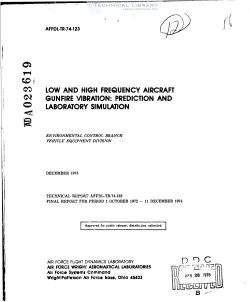AFFDL-TR-74-123
- Version
- 371 Downloads
- 7.92 MB File Size
- 1 File Count
- March 1, 2017 Create Date
- March 1, 2017 Last Updated
Low and High Frequency Aircraft Gunfire Vibration; Prediction and Laboratory Simulation

This report was prepared in the Vehicle Equipment Division (FEE), Air Force Flight Dynamics Laboratory, Wright-Patterson Air Force Base, Ohio. The report contains the results Of an in-house research program to develop a vibration prediction technique and a laboratory test method for aircraft. exposed to gunfire environments. This work was conducted from 1 October 1972 to 11 December 1974 under Task 329A0301 with Robert W. Sevy as project engineer. The authors gratefully acknowledge the contribution Of Mark Hal ler , Special mention must 4950th/Digita1 Process ing Branch, Computer Center. be made Of the in-house laboratory contributions Of Harold Johnson in the fabrication of special equipment and assisstance in the tests. this work results from follow-on areas delineated in a previous study (Reference 1 ) a study which involved the development of a prediction rationale for afrcraft vibration induced by the gun blast pressure fields of aircraft armaments. The bulk of this past effort required the synthesis Of a prediction technique based on energy coupl ing between the gunfire blast pulses and the resultant structural response. The response spectrum was defined for the high frequency region and was expressed fn terms of acceleration power spectral density. In contrast, the low frequency region (below 300 Hz) rmained largely undefined. It is this subject, its explication and final integration into the high frequency random portion of the prediction rationale, that constitutes the first objective of this work. The second objective involves the develogment of a viable and economic laboratory test method to acconmdate the low and high frequency elements. In the process Of developing the first theæ a flexible prediction function is sumoned forth and adapted to the special conditions and requirements of this technology and so beconEs tre medium through which the idea conduces to the achievement. Among the results of this work is Revision C to MIL-STD-810, "kthod 519.2 Gunfire Vibration, Aircraft" which is included as Appendix A.
| File | Action |
|---|---|
| AFFDL-TR-74-123 Low and High Frequency Aircraft Gunfire Vibration; Prediction and Laboratory Simulation.pdf | Download |

Comment On This Post